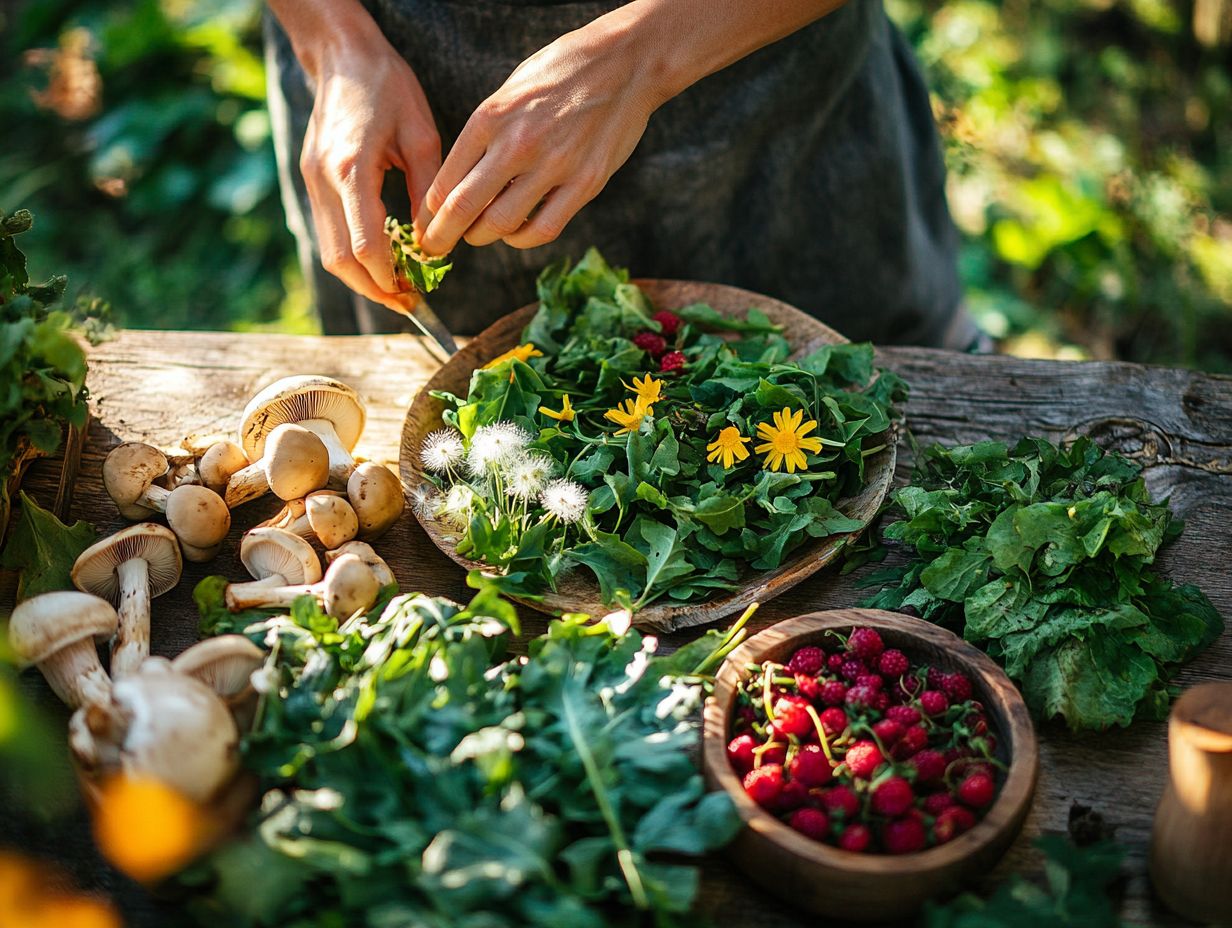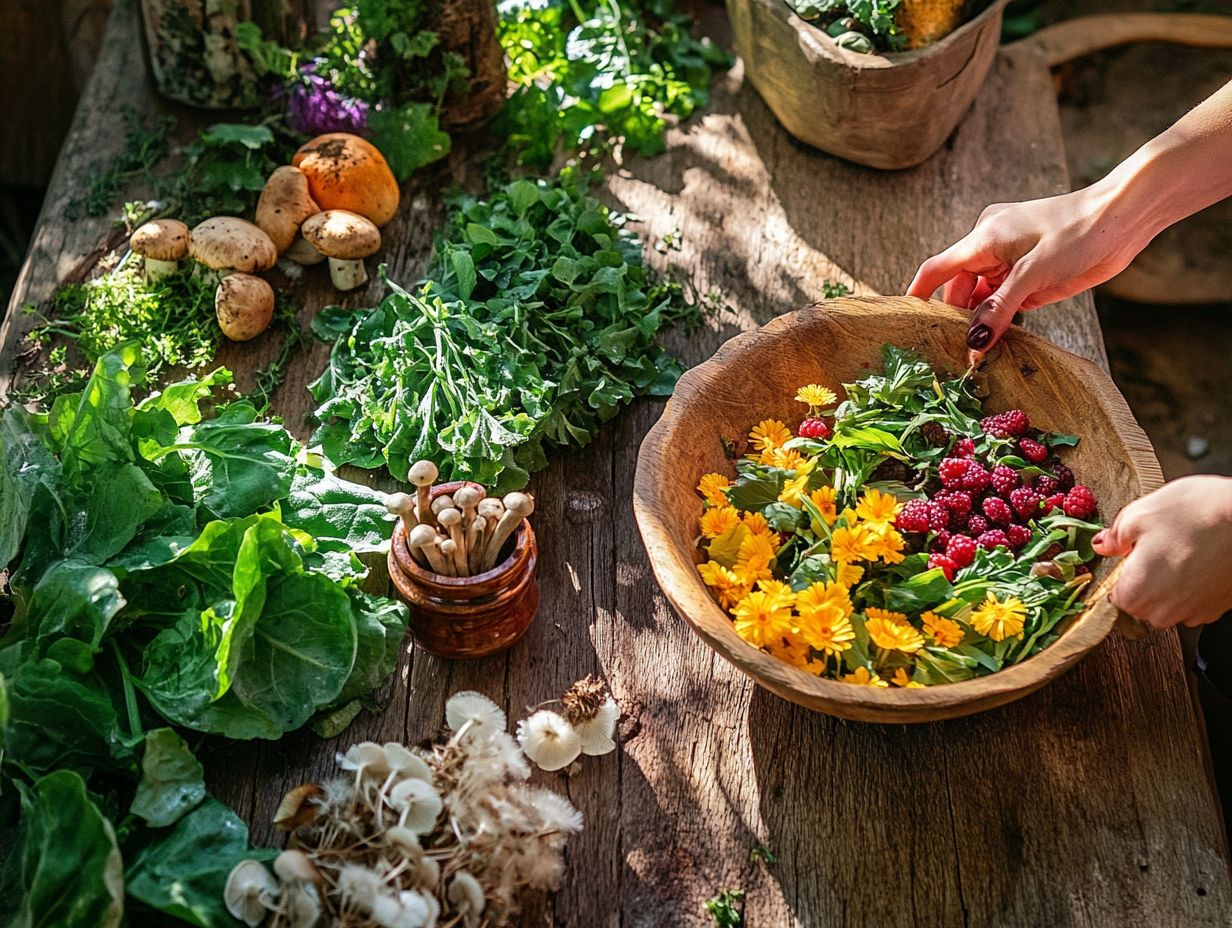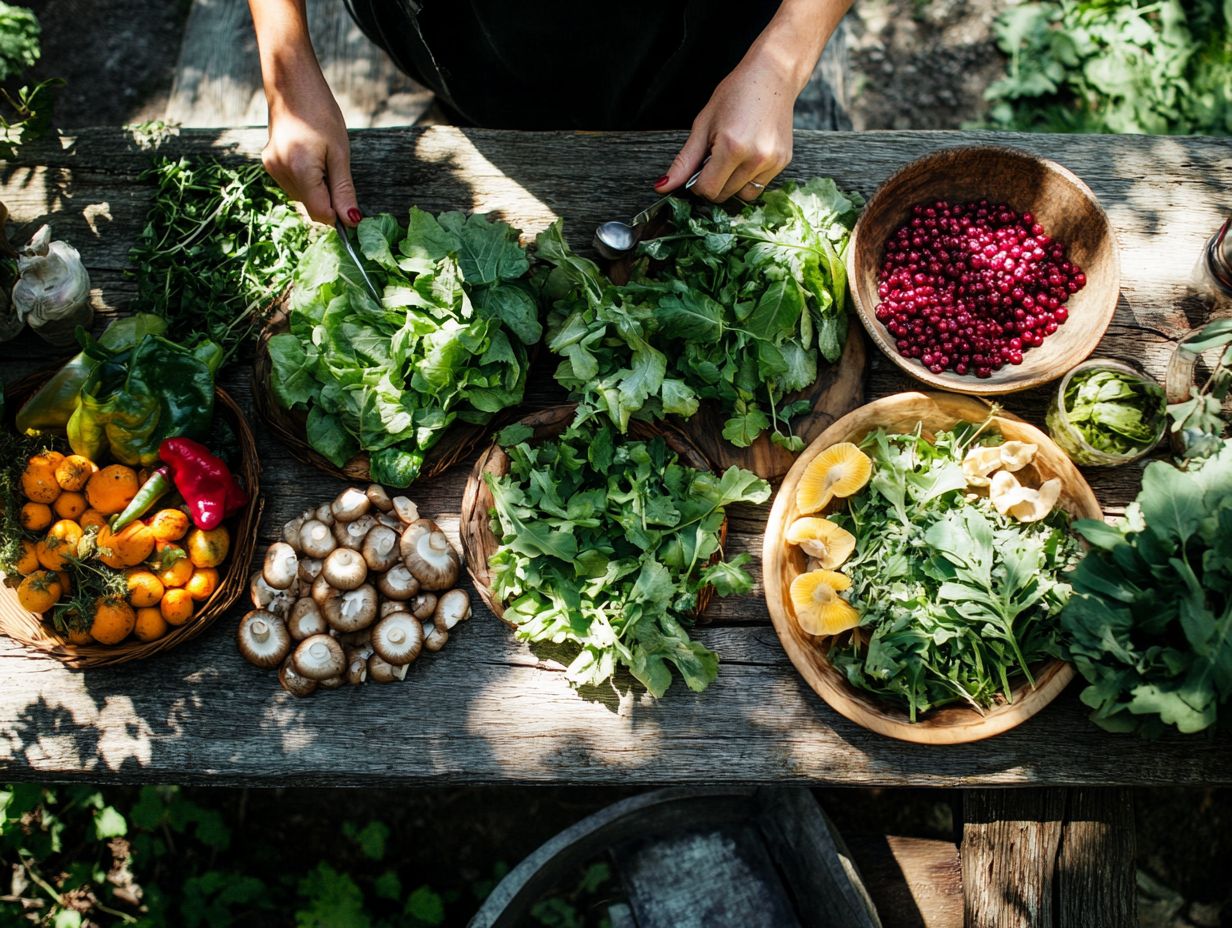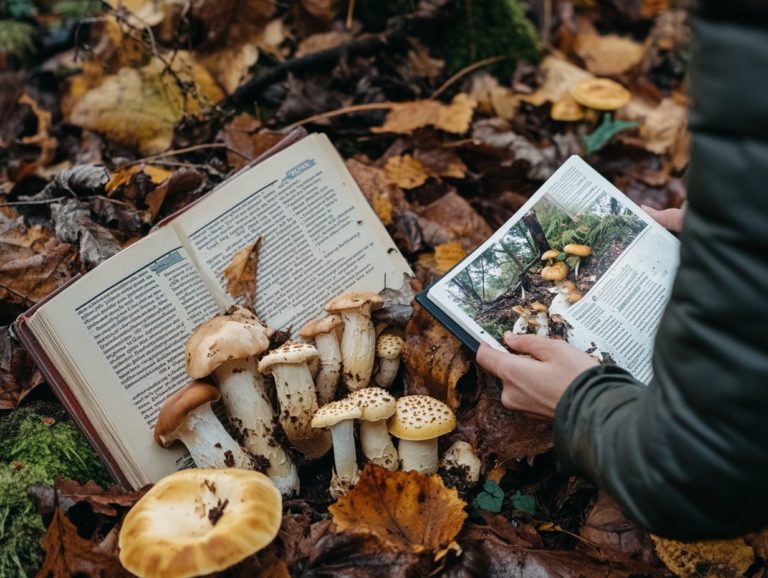What Can I Make with Foraged Edibles?
Foraging for edibles presents a rewarding adventure. It deepens your connection to nature while opening up a world of culinary possibilities.
As you wander through a forest, explore a local park, or even scout your own backyard, you’ll find a treasure trove of wild plants, mushrooms, and herbs waiting to enhance your meals.
This article delves into the benefits of foraging. It guides you on how to safely identify and harvest wild foods, provides delicious cooking tips, and outlines crucial safety precautions.
Get ready to dive into the incredible bounty nature has waiting for you!
Contents
- Key Takeaways:
- What Are Foraged Edibles?
- Benefits of Foraging for Food
- Identifying and Harvesting Foraged Edibles
- Cooking with Foraged Edibles
- Potential Risks and Precautions
- Identifying Poisonous Plants and Proper Handling
- Frequently Asked Questions
- What Can I Make with Foraged Edibles?
- Can I Cook with Foraged Edibles and Wild Ingredients?
- What Are Some Examples of Foraged Edibles and Wild Greens and Herbs?
- Are Foraged Edibles Safe to Eat?
- Can I Use Foraged Edibles in Baking and Fermentation Recipes?
- What Are the Benefits of Foraged Edibles and Foraging Wild Foods?
Key Takeaways:

- Foraged edibles are wild plants and fruits that can be sustainably sourced and used in cooking.
- Foraging for food has both health and environmental benefits, such as promoting a diverse diet and reducing food waste.
- Proper identification and safe harvesting techniques are crucial for incorporating foraged edibles into meals.
What Are Foraged Edibles?
Discovering Nature’s Treasures
Foraged edibles refer to wild plants and mushrooms that you can harvest directly from nature for consumption.
These treasures encompass a variety of species that thrive abundantly in natural habitats across North America.
Imagine exploring a rich tapestry of edible wild plants like vibrant greens and aromatic herbs, along with juicy berries, acorns, and nuts.
Don t overlook wild mushrooms; they can be both nutritious and delicious when identified and harvested correctly.
By familiarizing yourself with the types of foraged edibles available and their culinary applications, you can deepen your appreciation for nature s bounty while embracing a more sustainable lifestyle.
Benefits of Foraging for Food
Foraging for food presents a wealth of benefits that go far beyond the thrill of uncovering unique flavors.
It enhances your health, promotes sustainability, and fosters a deeper connection to the environment.
Engaging in the act of foraging encourages you to interact with nature. This steers you toward healthier dietary choices while reducing your dependence on commercially farmed products.
Many wild foods like mushrooms and wild greens provide essential nutrients and vibrant flavors that can elevate vegetarian recipes, transforming your meals into something truly exciting.
Health and Environmental Benefits
The health benefits of foraging reach far beyond your kitchen.
Foraged foods often boast superior nutritional value compared to their cultivated counterparts, enriching your diet with a wealth of vitamins and minerals.
By embracing foraging, you engage in sustainable practices that encourage the harvesting of local resources, effectively reducing your carbon footprint tied to food production and distribution.
Moreover, immersing yourself in nature through foraging can positively impact your mental health, fostering a deeper appreciation for the environment.
Take wild fruits, for instance; berries are brimming with antioxidants and frequently contain higher levels of phytonutrients than their farmed equivalents, promoting your overall well-being.
Foraged greens, like dandelion or wild spinach, present exceptional nutritional profiles, packed with essential vitamins A and C, calcium, and iron often thriving without the need for chemical fertilizers or pesticides.
The world of mushrooms is equally captivating; many wild varieties are not only delectable but also known to boost immune function.
By opting for foraged choices, you nourish your body while supporting biodiversity, creating a lifestyle that harmonizes with ecological health and sustainability.
Identifying and Harvesting Foraged Edibles

Identifying and harvesting foraged edibles is truly an art form. It seamlessly blends keen observation with an understanding of local flora and fungi.
To forage successfully, one must appreciate the distinct characteristics of edible wild plants and mushrooms. It’s essential to employ tips for identification to sidestep any potential hazards.
For those passionate about wild food recipes, the excitement of uncovering new ingredients in their natural habitat is rivaled only by the profound satisfaction that comes from knowing how to harvest them safely and sustainably for culinary delights.
Tools and Techniques for Safe and Sustainable Foraging
Equipping yourself with the right tools and techniques is essential for safe and sustainable foraging. This allows you to confidently identify and harvest wild mushrooms and greens.
A reliable, sharp knife is your best friend; it ensures clean cuts while minimizing damage to the surrounding flora. Opt for a sturdy basket or cloth bag for collection. This promotes air circulation and prevents bruising of the plants you’ve picked.
Utilizing a field guide or a smartphone app can significantly improve your ability to differentiate between edible species and their potentially harmful lookalikes.
As you forage, remember to practice mindfulness. When harvesting, make sure to leave behind roots, seeds, or spores to encourage regrowth. This thoughtful approach is vital for maintaining biodiversity and preserving future foraging opportunities.
Cooking with Foraged Edibles
Cooking with foraged foods opens up exciting new flavors and textures, inviting you to explore the unique flavors and textures that wild ingredients offer. Imagine crafting recipes that showcase the natural tastes of mushrooms, wild greens, and berries, transforming your kitchen into a vibrant playground of creativity.
You can also improve your dishes by experimenting with preservation techniques, like fermentation. This deepens your connection to nature and the food you enjoy.
Using foraged ingredients enhances your cooking and allows you to savor the wild essence of each meal.
Tips and Recipes for Incorporating Foraged Foods into Meals
Incorporating foraged foods into your meals can be a delightful endeavor. Whether you’re adding wild greens to salads or crafting vegetarian mushroom dishes that celebrate the rich flavors of morels and chanterelles, it’s important to think about what wildlife to consider while foraging, as the possibilities are endless.
Don’t miss the chance to impress your guests with unique beverages that capture the essence of the season s bounty. Explore foraged cocktail recipes featuring ingredients like elderflower and sloe gin.
Understanding the best practices for wild asparagus harvesting will elevate your culinary repertoire, showcasing the versatility and joy of cooking with these wild ingredients.
Experimenting with vibrant, untamed flavors can lead to unexpected culinary delights. Consider blending foraged herbs such as wild garlic or wood sorrel into your homemade pestos or butters to enrich your dishes with depth and complexity.
For sweet indulgences, transform foraged berries like blackberries or blueberries into jams or compotes that pair beautifully with cheeses or breakfast items.
Embrace a variety of cooking techniques whether you re pickling, fermenting, or simply saut ing to unlock the true essence of these natural ingredients. This transforms everyday meals into extraordinary culinary adventures.
Potential Risks and Precautions

Foraging for wild foods can be a truly rewarding experience, but it’s crucial for you to be aware of the potential risks that come with it. Taking the necessary precautions is essential to ensure your safety.
Properly identifying edible species, especially wild mushrooms, is of utmost importance. Many toxic plants and fungi can closely resemble their safe counterparts. By following mushroom identification tips and recognizing the signs of toxic plants, you can avoid dangerous encounters and fully relish the delights of your foraging adventures.
Identifying Poisonous Plants and Proper Handling
Identifying poisonous plants is crucial for anyone interested in foraging. Consuming toxic species can lead to serious health issues.
By understanding the key characteristics of these harmful plants and applying mushroom identification tips, you can effectively differentiate between safe and dangerous varieties. Adopting proper handling practices maximizes safety and preserves the delightful flavors of your foraged finds.
It s crucial to pay attention to features like leaf shape, flower color, and overall plant structure. These traits can vary significantly among species. For example, some poisonous plants might boast bright berries that seem tempting but are actually hidden hazards.
Regarding mushrooms, knowing the basics of gills, caps, and spore prints can prove invaluable. Equip yourself with knowledge from reputable field guides and consider attending local workshops to deepen your understanding.
Sharing insights in community forums can improve your knowledge about which species to steer clear of and how to handle your foraged treasures safely.
Frequently Asked Questions
What Can I Make with Foraged Edibles?
Foraged edibles are wild plants or fungi that can be used for culinary purposes. They can be found in nature and used in a variety of dishes.
Can I Cook with Foraged Edibles and Wild Ingredients?
Yes, there are many delicious recipes that incorporate foraged edibles. If you’re wondering what edible plants you can forage in winter, you can use them in salads, soups, stews, and even desserts.
What Are Some Examples of Foraged Edibles and Wild Greens and Herbs?
Foraged edibles can include wild berries, mushrooms, greens, nuts, and flowers. If you’re curious about what specific options are available, you might find it helpful to explore what edibles can be foraged in wetlands, such as blackberries, chanterelle mushrooms, dandelion greens, walnuts, and elderflowers.
Are Foraged Edibles Safe to Eat?
It is important to properly identify foraged edibles before consuming them. Some wild plants can be poisonous, so it is best to consult a field guide or an experienced forager before eating them.
Can I Use Foraged Edibles in Baking and Fermentation Recipes?
Absolutely! Foraged edibles can add unique flavors and textures to baked goods. You can use them in pies, cakes, breads, and more.
What Are the Benefits of Foraged Edibles and Foraging Wild Foods?
Foraging can be a thrilling adventure! Discovering wild ingredients adds a unique touch to your meals. Foraged edibles also tend to be more nutrient-dense and have a lower environmental impact than store-bought produce.
Join a local foraging group today!







